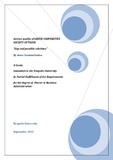| dc.contributor.author | Constantinidou, Anna | |
| dc.date.accessioned | 2016-01-14T11:34:24Z | |
| dc.date.available | 2016-01-14T11:34:24Z | |
| dc.date.issued | 2012-09 | |
| dc.identifier.uri | http://hdl.handle.net/11728/7072 | |
| dc.description.abstract | The paper aims to find the gap between perceptions and expectations of services quality in Greek Cooperative Society of Pafos (COOP bank). The degree of business success is based on the ability to maintain loyal customers and good relations with customers and employees because as it is known the cost of taking a new customer is five to seven times higher than to retain an existing. Also with an increase in customer retention by 5% you can increase your profit by 25% to 95%. Maintaining no gap between customer expectation and perception is very important because if the customer knows what you offer then he/she is satisfied and doesn’t get surprised (Tea and sympathy-short case, William J. Stephenson 2009). The research used the method of SERVQUAL model. During this study a limitation of this method is deriving, empirically we can say that is not easily understandable. Specifically the scoring of expectation is not given hierarchically, people usually ask for the perfect, the way the questionnaire was build did not help them to avoid this mistake. From the results we can see that all dimensions received high expectation scores from most customers, the mode for three dimensions has average expectation scores of 7, 6.25 and 5.75. This is may be an area for future studies.
The methodology used to analyse the results includes the following:
- Calculation of the unweighted average SERVQUAL scores.
- Calculation of the weighted average SERVQUAL scores.
- Calculation of the gaps and
- Calculation of the Mode
- Importance Performance analysis
For additional information also KANO Model it could be used.
The overall unweighted average SERVQUAL score is 6.233 out of seven or 89% of performance and the weighted average scores is 6.253 out of seven, or 89.33%. Both seem to be satisfactory scores. However, all five dimensions have a negative gap. The average gap is 0.827; this shows that the quality of service that is given to customers is 11.08% lower than their expectations. Based on the average gap scores of each dimension and on the results of Importance Performance Analysis, “Assurance” and “Tangibles” seem to need the most attention by management, while the least attention should be given to “Responsiveness” which has the lower gap, (17/%).
Management must train the employees to inspire assurance to customers. Employees must be able to answer all customers’ questions and make them feel confidence during their transactions. Also guidelines must be given to improve the use of equipment and the aesthetic of the branches. | en_UK |
| dc.language.iso | en | en_UK |
| dc.publisher | Business Administration Program, School of Economics Sciences and Business, Neapolis University Paphos | en_UK |
| dc.rights | Απαγορεύεται η δημοσίευση ή αναπαραγωγή, ηλεκτρονική ή άλλη χωρίς τη γραπτή συγκατάθεση του δημιουργού και κάτοχου των πνευματικών δικαιωμάτων | en_UK |
| dc.rights.uri | http://creativecommons.org/licenses/by-nc-nd/4.0/ | en_UK |
| dc.subject | Research Subject Categories::SOCIAL SCIENCES::Business and economics | en_UK |
| dc.subject | Services quality | en_UK |
| dc.subject | SERVQUAL model | en_UK |
| dc.title | Service quality of Greek cooperative society of Pafos | en_UK |
| dc.type | Thesis | en_UK |



